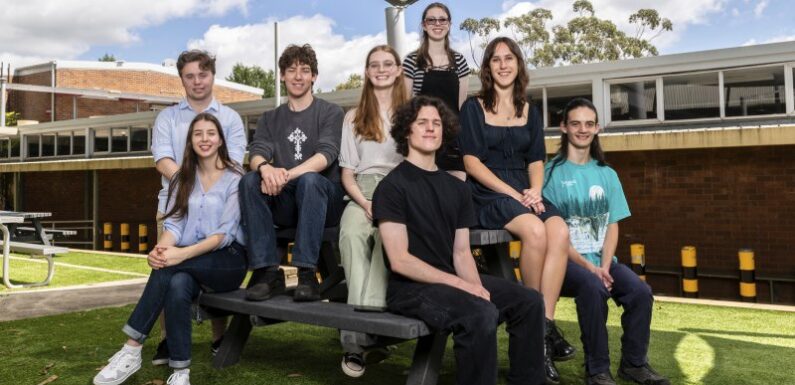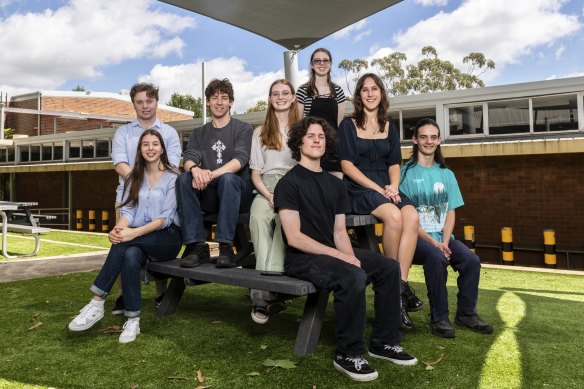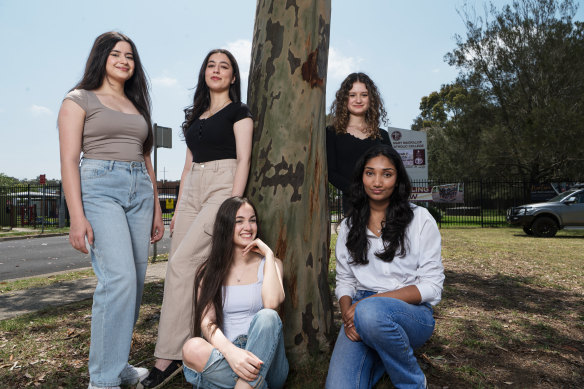
Save articles for later
Add articles to your saved list and come back to them any time.
The principal of Moss Vale High, Patricia Holmes, says the regional school’s leap of 200 places in the Herald’s latest HSC rankings has been some eight years in the making.
“Our results have been creeping up steadily for a while, and that’s happened as there’s been a shift in the culture at the school,” says Holmes, a former English teacher who has taught in the state’s public education system for three decades.
Year 12 students at Moss Vale High after receiving their HSC results last week.Credit: Rhett Wyman
“In the junior years we have an intense focus on literacy and numeracy, teaching good study habits and expectations around behaviour, as well as the skills students need to be resilient,” she says.
Enrolments at Moss Vale, a comprehensive public school just south of Bowral, have leapt by about 60 per cent since 2016 to about 800 students. In this year’s HSC results, the school punched above its weight, finishing 125th on the rankings, with a higher success rate than at least 160 schools where students are from the same or more advantaged backgrounds.
From next year, the school will run 50-minute literacy classes – separate from regular English lessons – to teach grammar, punctuation and writing skills to year 7, 8 and 9 students.
“Literacy is the key to lifting success rates and understanding test questions across all subjects. And some of those foundational skills haven’t been as much of a focus in high school,” says Holmes.
The Herald’s rankings are on schools with at least 150 entries in HSC courses and based on their success rate of getting band sixes, which reflects marks of 90 and above. The state government releases results for students only in the top performance band, which means rankings generally celebrate academically selective and high-fee private schools.
HSC students at Mary MacKillop College after receiving their results.Credit: Flavio Brancaleone
Around the state, schools in less advantaged areas have achieved high HSC success rates. At Fairfield’s Mary MacKillop College, two-thirds of students are in the lowest quartile of socio-educational advantage.
The all-girls Catholic school had 58 distinguished achievers (students who achieved a result in the highest band) and a success rate – the ratio of top scores to total exams sat – of almost 10 per cent.
Principal Gilda Pussich said three students had achieved all-rounder status (five or more scores above 90), including the school’s dux, An Nguyen, scoring an ATAR of 99.6.
“The girls have this real sense of belief in their ability, that they can succeed. Chemistry was one of our strongest subjects this year in terms of being above state average,” says Pussich.
The school has an ICSEA score – an index that measures students’ socio-educational advantage – of 934, among the lowest quarter in the state. “About 30 per cent of our year 12 students are recent arrival refugees, and the vast majority have a language background other than English,” she says.
“Over the past six years we’ve put a huge focus on literacy and numeracy, and we are seeing that reflected in our high NAPLAN results too. We teach high-impact study skills on Thursday afternoons for two hours to year 12s, and also hold study sessions in the library in the evenings.”
In the school’s latest NAPLAN results, released last week, students received well above average scores in almost all domains in year 7 and 9 when compared with pupils from a similar background.
At Moss Vale High, Holmes said one major shift in the past eight years has been “explicitly teaching students what is expected in terms of their behaviour in the classroom”.
“We now have a school that is calm, and focused on teaching and learning. You can walk past any classroom and the students are engaged and focused on learning and we don’t have a high staff turnover rate.”
“We have raised expectations in all areas, including behaviour, learning and in how the uniform is worn. We teach students they don’t have a right to disrupt the learning of other students, or the teacher from teaching.”
Holmes said the school holds weekly assemblies and year meetings to highlight student achievement. “Every year we would have at least 10 to 12 teachers do HSC marking because it’s just invaluable professional learning.
“In the early days I used to have push-back around our uniform rules. People would say we were too strict. But raising the bar on presentation has had a flow-on effect to other aspects of school life. We are also getting more enrolments from feeder primary schools in the area that historically went to private schools.”
At Parkes High, in the central west, principal Sandra Carter said the school has also intensified its focus on literacy and numeracy in the past few years. This year it recorded its best result in more than eight years, rising more than 200 places. Its success rate lifted from 1.5 per cent to 6.5 per cent.
The school’s ICSEA score is 914, putting it in the 12th percentile, more than 80 points below the top schools.
“One of the best things to happen was the phone ban in schools. It has removed distraction. We are also holding a reading program as part of English lessons to reinvigorate that love of books,” Carter says.
Most Viewed in National
From our partners
Source: Read Full Article

